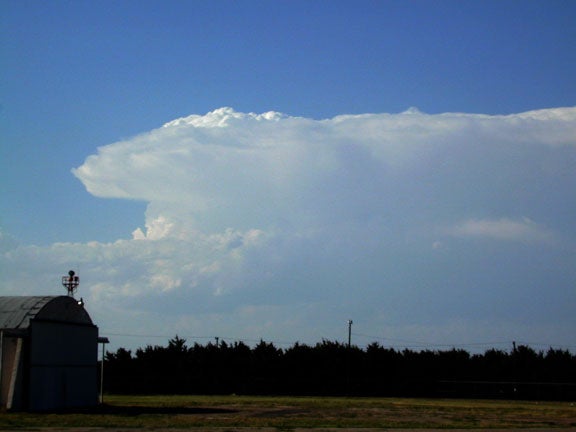STEPS
Severe Thunderstorm Electrification and Precipitation Study
 |
|
Figure 1: Picture of a target storm during STEPS Project (Click for full resolution).
|
STEPS had two broad goals concerning storm electricity:
- to improve understanding of how severe storms become electrified and
- to better understand how variations in the type and flash rate of lightning relate to the type of severe storm and its evolution. Of particular interest were severe storms that produce unusual lightning activity. Unusual lightning includes ground flashes that lower positive charge to the ground instead of the usual negative charge and cloud flashes whose polarity of electric current is reversed from the polarity normally found in a given storm region.
STEPS collected data from May 22-July 16, 2000 near the Colorado-Kansas border, a region of the country with the highest incidence of positive ground flashes. Besides wanting to learn what electrical characteristics a storm must have to produce positive ground flashes, scientists wanted to confirm and learn why positive ground flashes often are associated with the production of large hail. They also wanted to study how changes in the dominant polarity of ground flashes are associated with changes in the structure of a storm relative to its potential for tornadoes and other severe weather.
 |
|
Figure 2: Picture of the June 29, 2000, storm taken while T-28 was approaching the storm. Time is in GMT.
|
STEPS also collected data to discover if inverted-polarity cloud flashes are caused by storms having unusual electrical structures. Inverted-polarity cloud flashes have only recently been discovered by new technology for mapping lightning inside clouds, but an extraordinary number appear to have occurred during STEPS. An initial assessment of STEPS observations is that the electrical structure of at least a few storms was completely inverted throughout the entire storm depth. Though scientists have searched for electrically inverted storms for many years, the few observations supporting their existence have been inconclusive. STEPS data are capable of providing conclusive evidence. To verify that such storms occur and to try to explain why, scientists are beginning a detailed intercomparison of electrical structure, lightning location and structure, wind structure, and the distribution of various types of precipitation inside storms.
All photos copyright University Corporation for Atmospheric Research unless otherwise noted.
Data Manager
- EOL Archive, NCAR/EOL/DMS